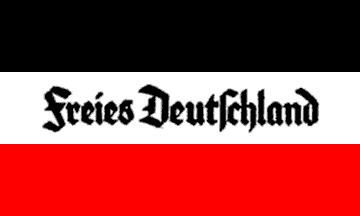Founded 1943 | ||
 | ||
The National Committee for a Free Germany (German: Nationalkomitee Freies Deutschland, or NKFD) was a German anti-Nazi organization that operated in the Soviet Union during World War II.
Contents
History
The rise of the Nazi Party to power in Germany in 1933 led to the outlawing of the Communist Party of Germany (KPD) and persecutions of its members, many of whom fled to the Soviet Union.
With the German invasion of the Soviet Union in Operation Barbarossa, German prisoners of war began to fall into Soviet hands. Several attempts to establish an anti-Nazi organization from those POWs were made with little success since most of them still believed in the final victory of the Wehrmacht.
With the German defeat at the Battle of Stalingrad, the number of German POWs rose and their belief in a victorious Germany was damaged, hence they were more open to the idea of a membership in an anti-Nazi organization.
At the beginning of June, 1943, Alfred Kunella and Rudolf Herrnstadt started to write the manifesto of the Committee, in which historical Prussian figures who allied with Imperial Russia against Napoleon were depicted as exemplary Germans (e.g. vom Stein, Arndt, Clausewitz and Yorck). The National Committee for a Free Germany (NKFD) was founded in Krasnogorsk, near Moscow on 12 July 1943; its president was the exiled German communist writer Erich Weinert, with his deputies Lieutenant Heinrich Graf von Einsiedel and Major Karl Hetz. Its leadership consisted of 38 members, including 28 Wehrmacht POWs and 10 exiled communists.
League of German Officers
After several failed attempts to recruit officers into the NKFD, it was suggested by Lieutenant-Colonel (German: Oberstleutnant) Alfred Brette that a special organization for officers be set up so that they would not have to come in contact with communists and common soldiers.
Two months after the founding of the NKFD, the League of German Officers (German: Bund Deutscher Offiziere, or BDO) was founded; its leader was General Walther von Seydlitz-Kurzbach. The main task of the BDO was to deliver propaganda aimed at the German armed forces. A number of officers held as Soviet prisoners of war eventually joined the BDO, the most prominent of them being Field-Marshal (German: Generalfeldmarschall) Friedrich Paulus, the commander of the Sixth Army captured at the Battle of Stalingrad. The BDO later merged with the NKFD.
Ideology
Although the NKFD operated in the Soviet Union and consisted partly of communists, it used conservative symbols and ideology. For example, the old flag colors of Imperial Germany (black, white and red) were used instead of the Weimar German (black, red and gold), as the Imperial colors were expected to be more popular among officers and soldiers of the conservative Army. The stated goal of the NKFD organisation was a return to the pre-war borders of 1937, the opening of negotiations for peace, and the deposing and punishment of the Nazi leadership. It also called for the preservation of the power of the Wehrmacht. The NKFD believed that German civilians and soldiers had to place the interests of the German nation above those of their Nazi leaders.
As the war progressed and it became increasingly clear that an anti-Nazi putsch would not occur, the NKFD's ideological line became more leftist until it became identical to that of the KPD.
Activity
NKFD and BDO activity focused on propaganda and had their own newspaper and radio station. They sent leaflets to German soldiers at the front and POWs in the Soviet camps. Red Army Major Lev Kopelev described the joint psychological warfare at Grudziądz in March 1945 by the Red Army and members of the NKFD. General Walther von Seydlitz-Kurzbach offered to raise an anti-Hitler army from NKFD and BDO members to fight against the Nazis, but the Soviets did not accept this offer.
Some NKFD members were attached to frontline Soviet units to interrogate German POWs and for propaganda purposes.
Other NKFD members fought behind the German lines alongside Soviet partisan units. Towards the very end of the war so-called "Seydlitz-Troops" were sent to the German lines in uniform with orders to blend in with the defenders and spread confusion. Some rejoined their former comrades and others followed their orders. Many were caught and executed.
As the Red Army entered Germany, some NKFD members were appointed as officials in the local government of the Soviet occupation zone.
Publications
Freies Deutschland was the weekly newspaper of the NKFD, published from 1943 to 1945.
Post-War
After the defeat of Nazi Germany, NKFD members mostly returned to the Soviet occupation zone in Germany and had a key role in building the German Democratic Republic. Some BDO members had a key role in building the National People's Army, while others (like Seydlitz), were prosecuted as war criminals.
